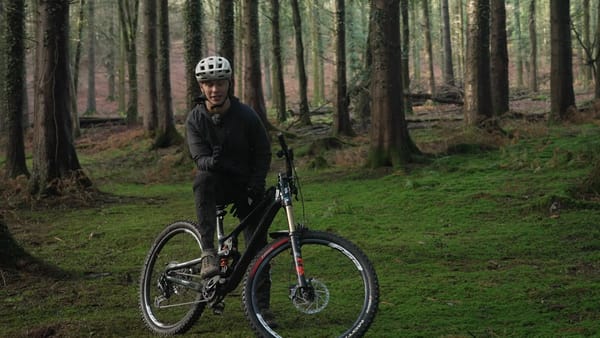Indoor vs. Outdoor Cycling: Finding Your Missing Watts
Discover what causes indoor cycling power discrepancies and learn practical strategies—from improving mobility to adding airflow—to boost your performance and close the gap between your indoor and outdoor riding power.

Now that we’ve had the first real snowfall of the season and the bike lanes are transformed into gritty, icy challenges, I’ve shifted more of my training onto Zwift. Let’s face it: while the indoor trainer comes with a certain convenience and digital camaraderie, it also invites a curious discrepancy—why does a given power output often feel so much harder indoors than it does out on the open road?
It’s no secret that you might face a noticeable power gap when transitioning from outdoor rides to indoor sessions. Maybe you’ve wondered if the trainer’s calibration is off or if your legs suddenly decided to take a seasonal vacation. The truth is, you’re not alone. Many cyclists notice they struggle to produce the same wattage inside as they do outside. But before you point fingers at your trusty trainer, think about the underlying reasons behind this phenomenon. Understanding what makes indoor riding feel tougher can help you tackle your weaknesses head-on and ultimately make you a stronger, more well-rounded rider.
Why Does Indoor Power Often Fall Short?
For starters, riding outdoors provides your bike a certain freedom of movement. Especially during all-out sprints, your bike naturally rocks side-to-side beneath you, giving you added leverage and recruiting more of your upper body. Indoors, your bike is locked into a single plane, robbing you of that dynamic support. This not only makes it tougher to hit those same power highs, it also emphasizes any imbalances you might have in your pedaling mechanics.
Gravity: Your Frenemy in Cycling
Gravity isn’t just for punishing you on steep climbs—it can actually help you crank out higher wattage during sprints. When you stand and surge, your body weight shifts from your saddle to your pedals, delivering extra force. Outdoors, you can also rock the bike, aligning your center of gravity over the downward pedal, squeezing every last watt from that moment. Indoors, the lack of bike movement means you can’t tap into gravity’s full potential as easily, leaving you feeling a bit more sluggish.
Proper Alignment and the Power of Movement
Outdoor riding, especially when standing, lets you optimize joint alignment through micro-adjustments. Your feet, knees, and hips fall into a groove as the bike moves beneath you, maximizing efficient force transfer. Indoors, the bike’s immobility makes it harder to achieve that sweet spot. Standing on the trainer still allows you to use gravity, but with fewer alignment options, you’re likely missing out on precious watts.
Body Position: The Silent Saboteur
Ever notice how some riders bob and weave like they’re dancing on the bike, even when seated? That movement outdoors can compensate for weak hip stability, poor mobility, or underactive glutes. This subtle rocking aligns the pelvis and helps maintain power transfer through each pedal stroke. Indoors, with no room to sway, those same weaknesses reveal themselves. If your hips are unstable or your core could use a tune-up, you’ll feel it. Without the bike’s natural movement, every watt gets just a bit harder to push out.
Airflow and Heat: The Overlooked Factors
On the road, the cooling breeze is nature’s gift to cyclists, helping manage body heat and reduce perceived exertion. Indoors, you’re stuck with stagnant air and a rising body temperature that makes every interval feel like you’re riding through soup. Excess heat and dehydration are proven performance killers, so if you’re not turning on those fans and downing enough fluids, don’t be surprised when your power tapers off.
Mind Over Matter
Motivation is often higher outdoors, fueled by the thrill of the ride, scenic routes, and the presence of other riders to chase or drop. Indoors, the monotony can gnaw at your psyche, making perceived effort spike while actual power declines. Thanks to virtual cycling platforms and interactive group rides, though, you can trick your brain into pushing harder. Even if you’re solo, indoor training builds your mental grit—an essential skill when your legs start begging for mercy.
Bridging the Gap Between Indoor and Outdoor Power
If you find your power differs dramatically between indoor and outdoor sessions, don’t panic. First, identify the likely culprits: Are tight hip flexors restricting your mobility? Is a weak core limiting your pedal stroke efficiency? Is a lack of cooling making you wilt midway through a tough interval? Once you pinpoint your “why,” you can address it. Improve mobility, strengthen your core, or bring in that extra fan. Adjusting your indoor FTP can also help ensure your workouts remain challenging yet realistic, preventing distorted data from messing with your training progression.
For those who rely on perceived exertion rather than power meters, staying attentive to how you feel indoors versus outdoors can guide workout adjustments. Over time, the goal is to bring your indoor and outdoor numbers closer together—or at least understand why they differ—so you can train smarter and ride stronger, no matter the weather.





